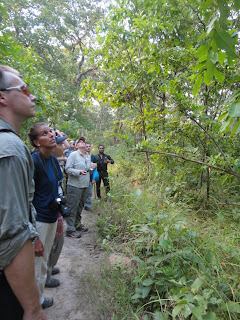We drive for 5 hours from Pokara to Chitwan national park, which lies in the flat lands of the Terai in the south of Nepal, close to the border with India. Chitwan is home to an ethnic group called the Tharu, who are thought to have migrated from the north of India. These people are generally very poor and only about 30% of their children go to school.
Photo 1 of Tharu house
The temperature has gone up while we have been driving and when we get out of the air-conditioned bus the heat and steaminess hits us. Pokara and Chitwan are the two tourist destinations of Nepali people.
Our hotel is rather as I imagine an African safari lodge might be. It has separate buildings for the rooms and restaurant is outside under a thatched roof. There is an open terrace which looks out over the river where we can watch herons fishing and water buffalo grazing.
Photo 2 of hotel
Photo 3 of view from the terrace
On our first day there we have fantastic encounters with elephants, which I will tell you about separately.
Later in the day we have a guide from the national park and we have a canoe ride down the river to spot crocodiles. The canoe is made from one whole cotton silk tree. We all get into one canoe, which sits very low in the water.
Photo 4 of canoes
As we float leisurely downstream the park guide points out various birds whose names can't remember and a kingfisher. He tells us that this is not a very good season for spotting crocodiles because it is so hot they tend to stay in the water, rather than lie on the bank. We are all a little nervous about being in such a low boat with crocodiles in the water! We do see several crocs on the banks. One is about 3m in length! I couldn't get a photo of them, as they were so well camouflaged.
He canoe pulls up at the shore and as we get out two working elephants lumber out of the jungle. They have been clearing dead trees and the mahouts have cut elephant grass to take back to the nearby elephant breeding centre for food.
Photo 5 of working elephants
The park guide takes us on a nature walk through the jungle, pointing out interesting things on the way.
Photo 6 of nature walk
Photo 7 of termite mound
The park is home to around 40 tigers, rhino, deer, sloth bears and elephants. Along one path we find a fresh tiger paw print. I should have put something down to make a size comparison, but the whole print is about the size of my hand.
Photo 8 of tiger paw print
The guide shows us a way to work out the height of the tiger. He picks a piece of grass and uses it to measure twice around the circumference of the paw print. This will be the height of the tiger.
Photo 9 of measuring the height of the tiger.
Our walk ends at the elephant breeding centre and it is dinner time. The elephants are tethered in open barns for feeding; otherwise they graze in the forest during the day. Females are kept for breeding and males are recruited into the Nepali army, which uses them to patrol national parks and prevent poaching, as well as for transport. The training regime for the young elephants sounds pretty harsh, with them being chained to a post.
Photo 10 of feeding time at the elephant breeding centre
There is a mother with a 3 month old baby, who trots around looking at the crowd of people.
Photo 11 of mother and baby
There is also a pair of 3 year old twins. For both twins to survive is very unusual. These two are boys and are already growing their tusks.
Photo 12 of mother and twins
In the evening we go into the local town and get tickets to the Tharu cultural show, which demonstrates the traditional music, song and dance of the Tharu people. We get to the culture hall just before the start of the show, but the performance is already sold out to Nepali and Indian tourist who are keen for their evening's entertainment. We hang around the town for an hour and then go back for the second performance.
The first dances are rather like our morris dance. The men dance in a circle and have two sticks which they use to whack the sticks of the other dancers.
Photo 13 of Tharu dancing
Only men are allowed to dance. This presents a problem if they want to represent women and results in men dressing up as women to dance. We watch a very strange dance which is used when a man has died. A young boy dresses up as the wife of the dead man and twirls his skirts wildly and an older man dresses up as the dead man's mother and skips around more sedately. It was introduced by the commentator as the 'lady-boy dance'!
At the end of each dance our group claps politely, but the Nepali and Indian tourists in the audience are strangely quiet and just sit there waiting for the next part of the show.
For the last part of the show the commentator invites the audience to join in with a circle dance. Guess who is up there first? Kieran and Debbie follow me and come up on stage too.
Photo 14 of me and Kieran joining in














No comments:
Post a Comment